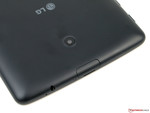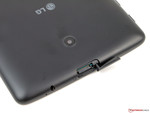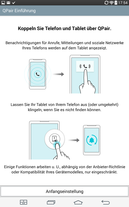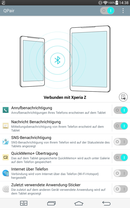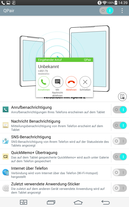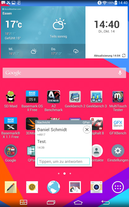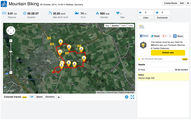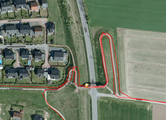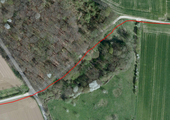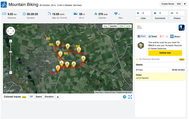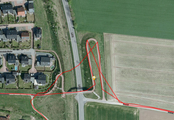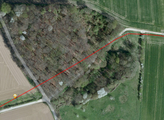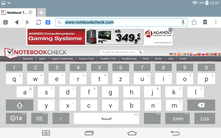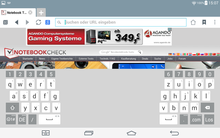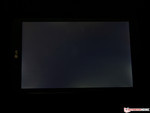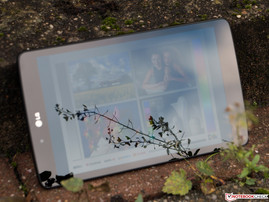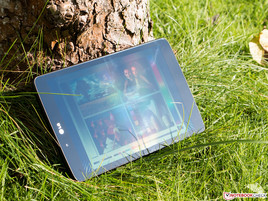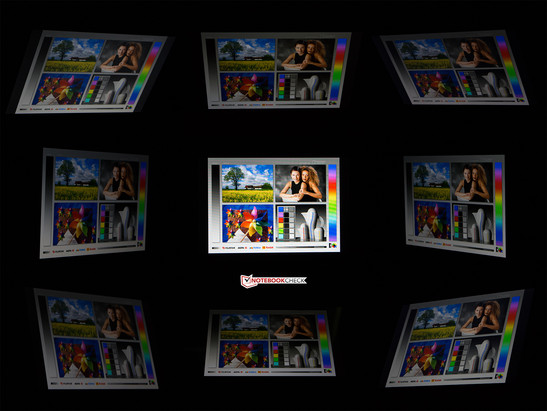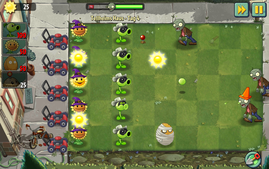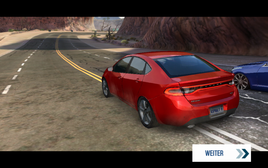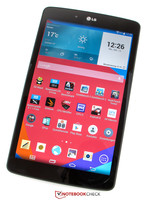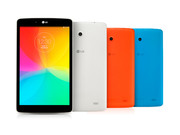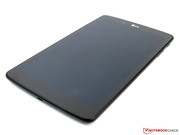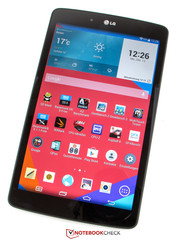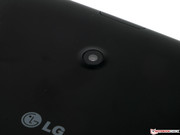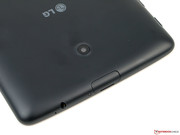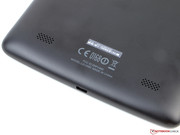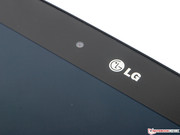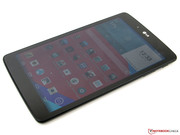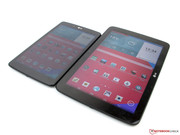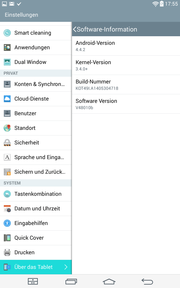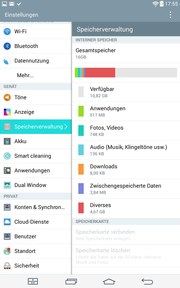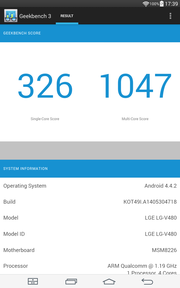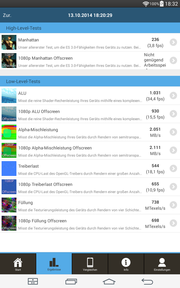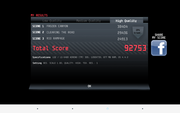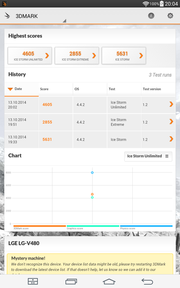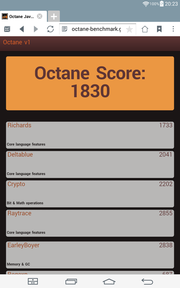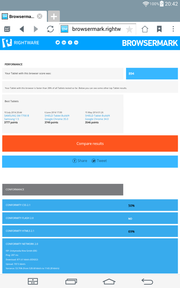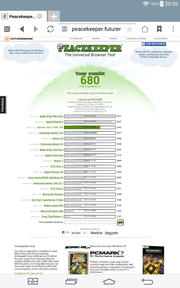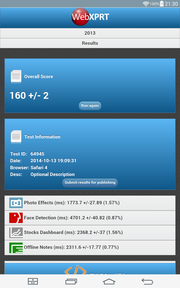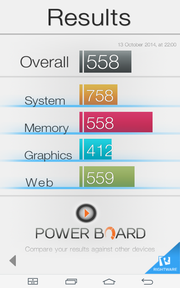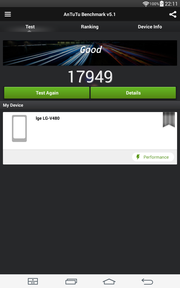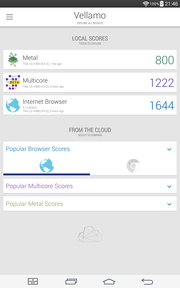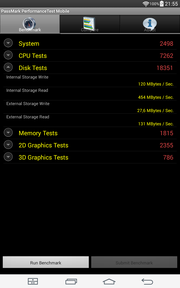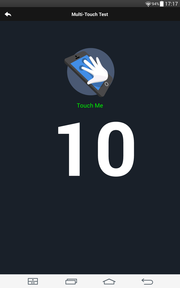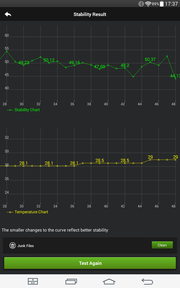LG G Pad 8.0 V480 Tablet Review

For the original German review, see here.
As the name already indicates, LG's G Pad 8.0 V480 features an eight-inch touchscreen. The resolution corresponds to the standard of this device category while the installed hardware sooner comes from the entry-level sector. The tablet does not offer any real hardware highlights, and the incorporated infrared transmitter is the only exception. The device's RRP of 199 Euros (~$253) is still acceptable for this sector. An identically configured LTE version is available for 100 Euros (~$127) extra.
The Acer Iconia Tab 8 A1-840FHD (starts at 199 Euros, ~$253), Huawei MediaPad M1 8.0 (starts at 208 Euros, ~$264), and Lenovo A8-50 (starts at 139 Euros, ~$176) are contenders. However, the Samsung Galaxy Tab 3 8.0 SM-T310 (starts at 140 Euros, ~$178) is still an alternative.
Case
LG's G Pad 8.0 is comfortable to hold even for a longer time owing to its rounded edges. The screen's edges are pleasantly slight, and only the Galaxy Tab 3 and MediaPad M1 have even narrower frames. It is, however, the thickest tablet in the comparison field with a depth of 9.9 millimeters. However, its weight of just 338 grams is relatively light, and only the Tab 3 (314 gr.) undercuts it.
The choice of materials is acceptable. The plastic has been roughened slightly, and thus the device has a good grip despite its smooth surface. The casing is available in black, white, orange, or blue.
The review sample's stiffness is not awe-inspiring. Although the slightest twisting attempts hardly produced cracking noises, the brightness distribution on the screen changed visibly. Light pressure on the tablet's back caused evident waves on the screen. A bit more force had to be applied to the display's bezel to imitate this effect.
The tablet's battery is not removable, and thus it cannot be replaced by the user. The micro-SD slot flap closes flush and is easy to open and close. The other gaps are fairly even, but the plastic back cover can be pushed away from the display quite effortlessly.
Connectivity
The device can be recharged and data can be shared with a computer via the micro-USB 2.0 port in LG's G Pad 8.0. It also supports OTG so that it is possible to connect USB sticks and external input devices to the tablet.
The micro-SD slot accepts memory cards with a maximum capacity of 64 GB. Since the system also supports App2SD, applications can be easily installed on it and started from there.
The infrared transmitter can be used for controlling TVs, Blu-ray and DVD players in conjunction with the app QuickRemote.
Software
Google's Android 4.4.2 KitKat operating system is used. LG has modified the interface, and it blends in perfectly with the overall concept of LG's product line. The G Pad 8.0 also completely exhausts the proprietary software features. In addition to Knock Code, QPair, and QuickRemote, Dual Windows for multitasking is also available. This software is known from LG's G3.
QPair that can be used with all Android smartphones with at least version 4.3 proved particularly useful. The program connects a smartphone with the tablet so that it not only can use the phone's Internet connection but also receive and answer calls, short messages, and notifications from social networks. It is also possible to locate the other device via an acoustic signal when it has been misplaced.
There are only a handful of third-party apps, which can be deleted easily.
Communication & GPS
LG's G Pad 8.0 sports a Wi-Fi module that supports the IEEE 802.11 a/b/g/n standards. It can consequently operate in both the 2.4 and 5.0 GHz frequency ranges. The tablet's range is good. Half the signal strength was still displayed even 20 meters away from the router (Fritz!Box 6360). It was also still possible to browse on the Internet without a noticeable decrease in speed.
Bluetooth 4.0 is also installed. Audio streaming is no problem. However, users who transmit the audio of a streamed HD video to an external speaker will notice that the sound is not always in-sync. Besides that, a noise is heard after playing a sound, which stops with a "snap" after a few seconds.
The tablet can use both GPS and Glonass satellites for localization. Satellites are found quickly outdoors, and the position is ascertained within a few seconds. It takes considerably longer indoors, but localization is possible.
The accuracy of the G Pad 8.0 could be better. Compared with the Garmin Edge 500 bike computer, the tablet exhibited problems in tight route sections, such as in the vicinity of a bridge. The deviations are also very evident under difficult reception conditions like in the woods. However, the discrepancies are a low 3% when looking at the total route, which is a very good outcome.
Cameras
LG's G Pad 8.0 has two cameras. The front-facing camera is primarily suitable for videoconferencing with a resolution of 1.2 MP (1280x800 pixels; 16:9). Selfies are easy to take via a self-timer that can be triggered via gestures.
The self-timer can also be used with the primary camera that has a resolution of 5 MP (2560x1920). There is no auxiliary light or flash, and the other properties in low light are also unsatisfactory. The lens, however, shoots useful results in a bright surrounding or in daylight. The low resolution results in a lack of sharpness, which is particularly evident in rich-detail sequences where the outlines are blurry to muddy. Colors are very intense so that the pictures look quite vivid.
Panoramas can also be shot with the camera. That is quite easy to do and delivers attractive results. LG does not install other modes, and the settings are also limited to the essentials.
Accessories
The accessories for LG's G Pad 8.0 are comprised of a modular power supply (5 volts, 1.8 ampere) with an output of 9 watts, a USB data cable, and a quick-start guide.
The manufacturer does not offer any optionally purchasable, tablet-specific accessories.
Warranty
LG includes a 24-month warranty on its G Pad 8.0. The accessories are only protected for twelve months. The warranty cannot be upgraded.
Input Devices & Controls
The capacitive touchscreen detects up to ten simultaneous inputs. The surface features good gliding properties and implements inputs accurately. However, the device occasionally needs a second before responding. This could be due to the somewhat weaker processor because this is seldom with the Android interface, and it usually occurs in apps.
The G Pad 8.0 utilizes LG's Smart Keyboard with a nicely designed keyboard layout. The user can customize it to meet personal needs. For example, the key size can be changed or a key with an additional special character can be placed beside the space bar in the settings.
Display
LG's G Pad 8.0 has an 8-inch screen with a resolution of 1280x800 pixels. That corresponds to an aspect ratio of 16:10 and a pixel density of approximately 189 ppi. Though that is not particularly high, it should be sufficient for most purposes. Even videos in the small HD resolution (710p) can still be played in the native resolution. Users who want to watch higher resolution material without losses will have to do this via an external monitor. Only Acer's Iconia Tab 8 (1920x1200 px; 16:10) offers a higher resolution in the comparison field.
The review sample's maximum brightness of 333 cd/m² is quite good but cannot compete with the leader Nvidia Shield (max. 489 cd/m²; 92%). The illumination of 85% is only middling, which is not noticed adversely in practice. A light clouding is visible at the screen's edges in dark images.
| |||||||||||||||||||||||||
Brightness Distribution: 85 %
Center on Battery: 333 cd/m²
Contrast: 617:1 (Black: 0.54 cd/m²)
ΔE ColorChecker Calman: 4.64 | ∀{0.5-29.43 Ø4.77}
ΔE Greyscale Calman: 4.78 | ∀{0.09-98 Ø5}
Gamma: 2.63
CCT: 6458 K
| LG G Pad 8.0 V480 Adreno 305, 400 MSM8226, 16 GB eMMC Flash | Acer Iconia Tab 8 HD Graphics (Bay Trail), Z3745, 16 GB SSD | Lenovo A8-50 SGX544, MT8121, 16 GB eMMC Flash | Samsung Galaxy Tab 3 8.0 SM-T310 Mali-400 MP4, 4212 1.5 GHz, 16 GB iNAND Flash | Huawei MediaPad M1 8.0 Mali-450 MP4, Kirin 910, 16 GB eMMC Flash | |
|---|---|---|---|---|---|
| Screen | -3% | 13% | 19% | 2% | |
| Brightness middle (cd/m²) | 333 | 330 -1% | 348.1 5% | 428 29% | 328 -2% |
| Brightness (cd/m²) | 311 | 316 2% | 322 4% | 413 33% | 308 -1% |
| Brightness Distribution (%) | 85 | 91 7% | 87 2% | 92 8% | 84 -1% |
| Black Level * (cd/m²) | 0.54 | 0.54 -0% | 0.452 16% | 0.56 -4% | 0.46 15% |
| Contrast (:1) | 617 | 611 -1% | 770 25% | 764 24% | 713 16% |
| Colorchecker dE 2000 * | 4.64 | 5.47 -18% | 4.41 5% | 4.2 9% | 5.23 -13% |
| Greyscale dE 2000 * | 4.78 | 5.36 -12% | 2.99 37% | 3.2 33% | 4.68 2% |
| Gamma | 2.63 84% | 2.14 103% | 2.21 100% | 2.46 89% | 2.15 102% |
| CCT | 6458 101% | 6342 102% | 6468 100% | 6621 98% | 7185 90% |
* ... smaller is better
The black level of 0.54 cd/m² is increased slightly so that actually black surfaces look dark gray. That is not significantly better in the contenders. Lenovo's A8-50 (0.45 cd/m²; 770:1) still does the best job in the comparison field and provides a better overall picture due to its higher contrast. The review sample has a contrast ratio of 617:1, which is good but not outstanding.
The color accuracy of LG's G Pad 8.0 is quite precise despite the device category. It only displays few visible shifts. A balanced overall image is seen in the grayscale (dE 4.8), and the slightest greenish cast is vaguely perceptible on a pure-white surface. Only red (dE 9.7) is noticed unfavorably in the mixed colors. Blue could be more saturated. This is, however, not noticed adversely in routine use.
The highly reflective surface particularly makes outdoor use difficult. The reflections are annoying even in the shade, and not much can be recognized on the screen in direct sunlight. The good contrast, unfortunately, cannot change this either.
The viewing-angle stability of LG's G Pad 8.0 is good. The installed IPS screen, however, has a minor drawback: its brightness decreases clearly starting at an angle of approximately 30 degrees, and a light glowing effect becomes visible. Otherwise, the viewing angles are stable even when they are extremely flat. These points of criticism are insignificant when the tablet is held in a typical manner.
Performance
LG's G Pad 8.0 is powered by a Qualcomm Snapdragon 400 MSM8226 processor that is supported by 1 GB of working memory. The quad-core SoC clocks with 1.2 GHz and is now also found in many entry-level smartphones. The SoC-integrated Qualcomm Adreno 305 performs graphics calculations. It is not brand new anymore and has problems primarily with graphically-demanding games. Minor stutters were noticed even when using the Android interface.
The review sample nevertheless made a relatively good impression in the benchmarks because it could permanently retrieve the SoC's full performance. Although the A8-50 (MT8121; 1300 MHz) achieves a better score in the single-core test of Geekbench 3 (351 points), it has a 100 MHz higher clock. Those are, however, only measurable differences. The deviation is not noticed in practice. It is much clearer when compared with performance behemoths like Nvidia's Shield tablet, which is one of the currently fastest devices in the market.
A mixed impression evolves in the graphics benchmarks. The devices with a MediaTek SoC all use an outdated PowerVR SGX544, which is slower than the Adreno 305 in the review sample. However, as the ARM Mali-450 MP4 in the MediaPad M1 proves, a much better performance can be achieved even in this device category. The G Pad's Adreno 305's age of two years old is noticed here. Former high-end games can still just be rendered smoothly as the ultra-benchmark of Epic Citadel shows. However, it is no longer state-of-the-art either.
| AnTuTu v5 - Total Score (sort by value) | |
| LG G Pad 8.0 V480 | |
| Acer Iconia Tab 8 | |
| Samsung Galaxy Tab S 8.4 | |
| NVIDIA Shield Tablet P1761W | |
| 3DMark | |
| 1280x720 Ice Storm Standard Score (sort by value) | |
| LG G Pad 8.0 V480 | |
| Samsung Galaxy Tab 3 8.0 SM-T310 | |
| Gigaset QV830 | |
| Lenovo Yoga Tablet 8 | |
| Lenovo A8-50 | |
| Acer Iconia Tab 8 | |
| Huawei MediaPad M1 8.0 | |
| 1280x720 Ice Storm Standard Graphics (sort by value) | |
| LG G Pad 8.0 V480 | |
| Samsung Galaxy Tab 3 8.0 SM-T310 | |
| Gigaset QV830 | |
| Lenovo Yoga Tablet 8 | |
| Acer Iconia Tab 8 | |
| Huawei MediaPad M1 8.0 | |
| 1280x720 Ice Storm Standard Physics (sort by value) | |
| LG G Pad 8.0 V480 | |
| Samsung Galaxy Tab 3 8.0 SM-T310 | |
| Gigaset QV830 | |
| Lenovo Yoga Tablet 8 | |
| Acer Iconia Tab 8 | |
| Huawei MediaPad M1 8.0 | |
| Epic Citadel - Ultra High Quality (sort by value) | |
| LG G Pad 8.0 V480 | |
| Gigaset QV830 | |
| Lenovo Yoga Tablet 8 | |
| Acer Iconia Tab 8 | |
| Samsung Galaxy Tab S 8.4 | |
| NVIDIA Shield Tablet P1761W | |
The Internet browsing speed could be faster. LG's G Pad 8.0 only set up sophisticated websites very slowly although we used the preloaded stock browser, which is based on Google's Chrome 30, for the benchmarks. The performance could very likely be increased with a more current version. The Iconia Tab 8.0 was always considerably faster in the comparison field.
| Peacekeeper - --- (sort by value) | |
| LG G Pad 8.0 V480 | |
| Samsung Galaxy Tab 3 8.0 SM-T310 | |
| Gigaset QV830 | |
| Lenovo Yoga Tablet 8 | |
| Lenovo A8-50 | |
| Acer Iconia Tab 8 | |
| Huawei MediaPad M1 8.0 | |
| Samsung Galaxy Tab S 8.4 | |
| Octane V2 - Total Score (sort by value) | |
| LG G Pad 8.0 V480 | |
| Lenovo Yoga Tablet 8 | |
| Acer Iconia Tab 8 | |
| Huawei MediaPad M1 8.0 | |
| Samsung Galaxy Tab S 8.4 | |
| NVIDIA Shield Tablet P1761W | |
| Mozilla Kraken 1.1 - Total (sort by value) | |
| LG G Pad 8.0 V480 | |
| Gigaset QV830 | |
| Lenovo Yoga Tablet 8 | |
| Acer Iconia Tab 8 | |
| Samsung Galaxy Tab S 8.4 | |
| NVIDIA Shield Tablet P1761W | |
* ... smaller is better
The internal storage of LG's G Pad 8.0 has a capacity of 16 GB. The user has 10.8 GB of that available. Since media often needs a lot of space, it is convenient that the storage can be expanded by up to 64 GB via a micro-SD card. The system supports App2SD, which enables relocating applications to the additional storage.
The flash storage's speed was always very good and did not provide any reason for reproach. There are only a few contenders faster in write speeds.
Games
Gaming is not in the nature of LG's G Pad 8.0. The Qualcomm Adreno 305 is only strong enough for simple titles like Angry Birds or Plants vs. Zombies. The user will have to count with stutters in more demanding games. Current games like Asphalt 8 can be played even in medium detail settings without reproduction errors, but they do not run without minor lags when they are reduced to very low even then. Neither the touchscreen nor the sensors give reason for complaint.
Emissions
Temperature
The surface temperatures of LG's G Pad 8.0 reached up to 31.6 °C in idle. The rates increased up to 37.1 °C during permanent load, which we simulate by running the Stability Test app for at least one hour. That is relatively warm and also the second-highest rate in the comparison field. The Yoga Tablet 8 (max. 32.2 °C) is the coolest device, and the Galaxy Tab 3 8.0 (max. 42.6 °C) heats up even more. All rates are, however, absolutely uncritical.
We use the battery test in GFXBench 3.0 to test the performance stability under permanent load. It runs an on-screen test thirty times in succession and records both the battery state and the frame rates. The performance remained stable over the entire period. Strangely, the battery's charge state also remained stable. We also observed this in the runtime tests. A full battery was displayed for quite a while only to drop abruptly at a later time.
(+) The maximum temperature on the upper side is 37.1 °C / 99 F, compared to the average of 33.6 °C / 92 F, ranging from 20.7 to 53.2 °C for the class Tablet.
(+) The bottom heats up to a maximum of 34.4 °C / 94 F, compared to the average of 33.2 °C / 92 F
(+) In idle usage, the average temperature for the upper side is 28.8 °C / 84 F, compared to the device average of 30 °C / 86 F.
Speakers
The two rear-sided speakers in LG's G Pad 8.0 do not sound very good. The trebles are slightly distorted in maximum volume. Basses are barely audible, and the mids are virtually non-existent, which makes a rather bad impression for the sound.
However, the sound output via the audio jack is quite good. But, we noticed a quiet background scratching in quieter parts.
Energy Management
Battery Runtime
The 4200 mAh battery in LG's G Pad 8.0 enables a very good battery life. The ascertained rates provide compelling results in both its maximum and minimum runtimes. Unfortunately, we could not determine the tablet's exact power consumption this time because the rates fluctuated too strongly during the assessment, and they sometimes even dropped to zero, which is simply not possible.
The Wi-Fi browsing test is more suitable for comparison. It is performed using a standardized brightness of 150 cd/m². Except for the Wi-Fi connection, all consumers are disabled, and a browser script opens a new website every 40 seconds. The G Pad 8.0 lasted for almost eleven hours, which is an excellent result. Only Huawei's MediaPad M1 8.0 achieves a longer runtime.
| LG G Pad 8.0 V480 Adreno 305, 400 MSM8226, 16 GB eMMC Flash | Acer Iconia Tab 8 HD Graphics (Bay Trail), Z3745, 16 GB SSD | Samsung Galaxy Tab 3 8.0 SM-T310 Mali-400 MP4, 4212 1.5 GHz, 16 GB iNAND Flash | Lenovo A8-50 SGX544, MT8121, 16 GB eMMC Flash | Huawei MediaPad M1 8.0 Mali-450 MP4, Kirin 910, 16 GB eMMC Flash | |
|---|---|---|---|---|---|
| Battery runtime | -38% | -43% | -17% | 15% | |
| Reader / Idle (h) | 30 | 13.7 -54% | 10.2 -66% | 21.8 -27% | |
| WiFi (h) | 10.9 | 6.4 -41% | 7.7 -29% | 9.3 -15% | 12.5 15% |
| Load (h) | 5.4 | 4.4 -19% | 3.6 -33% | 4.9 -9% |
Verdict
LG's G Pad 8.0 V480 is an 8-inch tablet where some compromises have to be made. Although the screen's resolution is high enough, some contenders have more to offer. Its performance is on par with many of its rivals, but they have been in the market for over one year now. The device could be a bit faster for its price of 199 Euros (~$253), and there is room for improvement particularly in the graphics performance. However, LG's tablet uses an up-to-date version of Google's Android and comes with some software bonuses that facilitate use considerably.
A big plus is found in the G Pad 8.0's outstanding battery life, which is only surpassed by the MediaPad M1. The highly reflective screen does not help make the review sample the perfect outdoor companion either. Also, the speakers are certainly not the best of their kind.
The G Pad might satisfy buyers looking for a tablet for home use. The performance is absolutely sufficient for communication apps, Internet, and watching videos. Only gamers should definitely keep their hands off this tablet.


